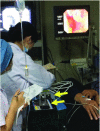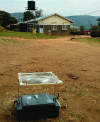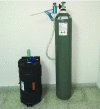The Role of Affordable, Point-of-Care Technologies for Cancer Care in Low- and Middle-Income Countries: A Review and Commentary
- PMID: 29204328
- PMCID: PMC5706528
- DOI: 10.1109/JTEHM.2017.2761764
The Role of Affordable, Point-of-Care Technologies for Cancer Care in Low- and Middle-Income Countries: A Review and Commentary
Abstract
As the burden of non-communicable diseases such as cancer continues to rise in low- and middle-income countries (LMICs), it is essential to identify and invest in promising solutions for cancer control and treatment. Point-of-care technologies (POCTs) have played critical roles in curbing infectious disease epidemics in both high- and low-income settings, and their successes can serve as a model for transforming cancer care in LMICs, where access to traditional clinical resources is often limited. The versatility, cost-effectiveness, and simplicity of POCTs warrant attention for their potential to revolutionize cancer detection, diagnosis, and treatment. This paper reviews the landscape of affordable POCTs for cancer care in LMICs with a focus on imaging tools, in vitro diagnostics, and treatment technologies and aspires to encourage innovation and further investment in this space.
Keywords: Cancer; imaging; in-vitro diagnostics; point-of-care technology.
Figures



Similar articles
-
The potential of diagnostic point-of-care tests (POCTs) for infectious and zoonotic animal diseases in developing countries: Technical, regulatory and sociocultural considerations.Transbound Emerg Dis. 2021 Jul;68(4):1835-1849. doi: 10.1111/tbed.13880. Epub 2020 Oct 30. Transbound Emerg Dis. 2021. PMID: 33058533 Free PMC article. Review.
-
Advances in technologies for cervical cancer detection in low-resource settings.Expert Rev Mol Diagn. 2019 Aug;19(8):695-714. doi: 10.1080/14737159.2019.1648213. Epub 2019 Aug 1. Expert Rev Mol Diagn. 2019. PMID: 31368827 Free PMC article. Review.
-
The social lives of point-of-care tests in low- and middle-income countries: a meta-ethnography.Health Policy Plan. 2024 Aug 8;39(7):782-798. doi: 10.1093/heapol/czae054. Health Policy Plan. 2024. PMID: 38907518 Free PMC article.
-
The National Institutes of Health Affordable Cancer Technologies Program: Improving Access to Resource-Appropriate Technologies for Cancer Detection, Diagnosis, Monitoring, and Treatment in Low- and Middle-Income Countries.IEEE J Transl Eng Health Med. 2016 Sep 8;4:2800708. doi: 10.1109/JTEHM.2016.2604485. eCollection 2016. IEEE J Transl Eng Health Med. 2016. PMID: 27730015 Free PMC article.
-
Frugal Innovation for Point-of-Care Diagnostics Controlling Outbreaks and Epidemics.ACS Biomater Sci Eng. 2020 May 11;6(5):2709-2725. doi: 10.1021/acsbiomaterials.9b01712. Epub 2020 Apr 13. ACS Biomater Sci Eng. 2020. PMID: 33463254
Cited by
-
Landscape of Global Oncology Research and Training at National Cancer Institute-Designated Cancer Centers: Results of the 2018 to 2019 Global Oncology Survey.J Glob Oncol. 2019 Nov;5:1-8. doi: 10.1200/JGO.19.00308. J Glob Oncol. 2019. PMID: 31756139 Free PMC article.
-
A Secure Occupational Therapy Framework for Monitoring Cancer Patients' Quality of Life.Sensors (Basel). 2019 Nov 29;19(23):5258. doi: 10.3390/s19235258. Sensors (Basel). 2019. PMID: 31795384 Free PMC article.
-
From potential to practice: how accelerating access to HPV tests and screen and treat programmes can help eliminate cervical cancer.Fam Med Community Health. 2019 Oct 31;7(4):e000182. doi: 10.1136/fmch-2019-000182. eCollection 2019. Fam Med Community Health. 2019. PMID: 32148728 Free PMC article. Review.
-
Evaluation of ABL90 and ABL800 Radiometer Blood Gas Analyzers: Challenges and Applications in Point-of-Care Cancer Diagnostics in Saudi Arabia.Healthcare (Basel). 2025 Feb 6;13(3):331. doi: 10.3390/healthcare13030331. Healthcare (Basel). 2025. PMID: 39942520 Free PMC article.
-
Point-of-care optical spectroscopy platform and ratio-metric algorithms for rapid and systematic functional characterization of biological models in vivo.J Biomed Opt. 2024 Dec;29(12):125002. doi: 10.1117/1.JBO.29.12.125002. Epub 2024 Dec 31. J Biomed Opt. 2024. PMID: 39741576 Free PMC article.
References
-
- Burkett B. J. and Hanemann C. W., “A review of supplemental screening ultrasound for breast cancer: Certain populations of women with dense breast tissue may benefit,” Acad. Radiol., vol. 23, no. 12, pp. 1604–1609, 2016. - PubMed
LinkOut - more resources
Full Text Sources
Other Literature Sources
Research Materials

